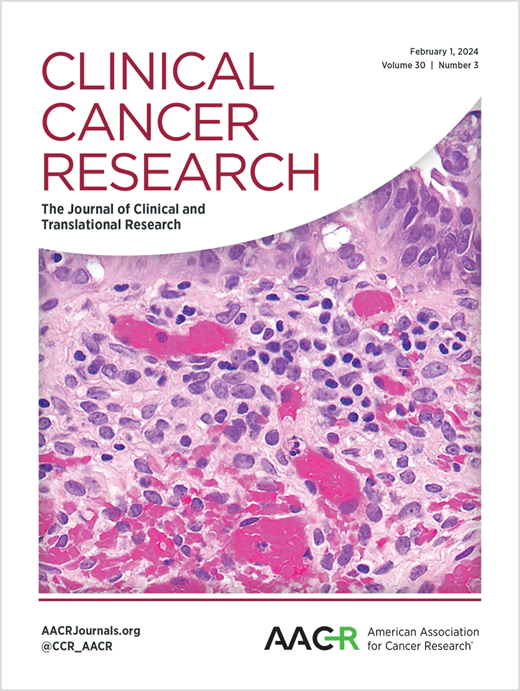Liquid and tissue biopsies for identifying MET exon 14 skipping NSCLC: Analyses from the Phase II VISION study of tepotinib.
IF 10
1区 医学
Q1 ONCOLOGY
引用次数: 0
Abstract
PURPOSE The VISION trial of tepotinib, a selective MET inhibitor, enrolled patients with NSCLC and prospectively detected MET exon 14 skipping (METex14) in liquid biopsies (LBx) and/or tissue biopsies (TBx). We evaluated patient characteristics and outcomes according to METex14 positivity in LBx (LBx-positive) or TBx (TBx-positive). METHODS METex14 was centrally assessed by next-generation sequencing of ctDNA from LBx (Guardant360®/Archer®MET) and/or RNA from TBx (Oncomine Focus/Archer®MET) or, in Japan only, local TBx polymerase chain reaction. Parallel LBx/TBx testing was recommended but not mandatory. Eligibility required LBx-positive or TBx-positive status. ctDNA burden was analyzed in patients with baseline Guardant360® data. RESULTS METex14 was detected in 469/7,937 prescreened/screened patients, of whom 313 were enrolled (TBx-positive, n=208; LBx-positive, n=178). LBx-positive patients had higher radiographic tumor burden than TBx-positive patients, including higher median sum of target lesion diameters per RECIST v1.1 (67.1 vs 55.2 mm), and more patients with ≥3 target lesions (27.5% vs 18.8%). In 180 TBx-positive patients with matching LBx results, objective response rates were slightly higher in TBx-positive/LBx-positive patients, but TBx-positive/LBx-negative patients had longer duration of response, progression-free survival (PFS), and overall survival (OS). In ctDNA analysis (n=165), detectable baseline ctDNA burden was associated with shorter PFS and OS. CONCLUSION Tepotinib had robust, durable activity in TBx-positive/LBx-negative and TBx-positive/LBx-positive patients. While LBx is a complementary method to TBx for detecting METex14, it may preferentially select patients with higher tumor burden and poorer prognosis. Undetectable METex14 in baseline ctDNA (due to low ctDNA shedding) may define more favorable treatment outcomes.液体和组织活检鉴定MET外显子14跳过NSCLC:来自替波替尼II期VISION研究的分析。
目的:选择性MET抑制剂替波替尼的VISION试验招募了非小细胞肺癌患者,并在液体活检(LBx)和/或组织活检(TBx)中前瞻性地检测MET外显子14跳变(METex14)。我们根据METex14在LBx (LBx阳性)或TBx (TBx阳性)中的阳性来评估患者的特征和结果。方法smetex14通过LBx的ctDNA (guarant360®/Archer®MET)和/或TBx的RNA (Oncomine Focus/Archer®MET)的下一代测序进行集中评估,或仅在日本使用当地TBx聚合酶链反应进行评估。推荐并行LBx/TBx测试,但不是强制性的。资格要求lbx阳性或tbx阳性状态。根据基线guarant360®数据分析患者的ctDNA负担。结果在7937例预筛/筛选患者中,469例检测到metex14,其中入组313例(tbx阳性,n=208;LBx-positive, n = 178)。lbx阳性患者的放射学肿瘤负担高于tbx阳性患者,包括每RECIST v1.1靶病变直径的中位数和更高(67.1 vs 55.2 mm),≥3个靶病变的患者更多(27.5% vs 18.8%)。在180例与LBx结果匹配的tbx阳性患者中,tbx阳性/LBx阳性患者的客观缓解率略高,但tbx阳性/LBx阴性患者的缓解持续时间、无进展生存期(PFS)和总生存期(OS)更长。在ctDNA分析(n=165)中,可检测的基线ctDNA负荷与较短的PFS和OS相关。结论替波替尼对tbx阳性/ lbx阴性和tbx阳性/ lbx阳性患者具有稳健、持久的活性。而LBx作为TBx检测METex14的补充方法,可能优先选择肿瘤负担较高、预后较差的患者。基线ctDNA中检测不到METex14(由于低ctDNA脱落)可能定义更有利的治疗结果。
本文章由计算机程序翻译,如有差异,请以英文原文为准。
求助全文
约1分钟内获得全文
求助全文
来源期刊

Clinical Cancer Research
医学-肿瘤学
CiteScore
20.10
自引率
1.70%
发文量
1207
审稿时长
2.1 months
期刊介绍:
Clinical Cancer Research is a journal focusing on groundbreaking research in cancer, specifically in the areas where the laboratory and the clinic intersect. Our primary interest lies in clinical trials that investigate novel treatments, accompanied by research on pharmacology, molecular alterations, and biomarkers that can predict response or resistance to these treatments. Furthermore, we prioritize laboratory and animal studies that explore new drugs and targeted agents with the potential to advance to clinical trials. We also encourage research on targetable mechanisms of cancer development, progression, and metastasis.
 求助内容:
求助内容: 应助结果提醒方式:
应助结果提醒方式:


